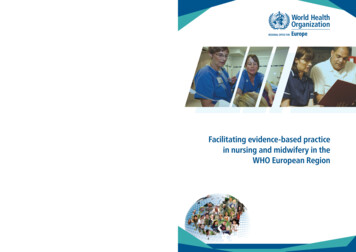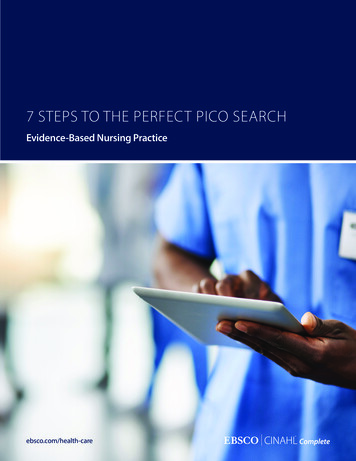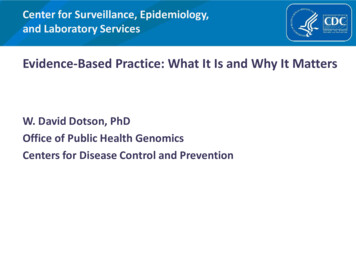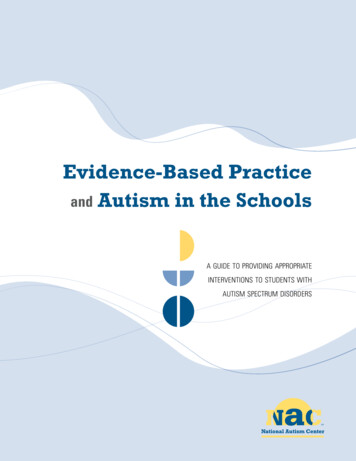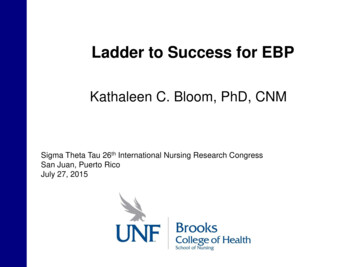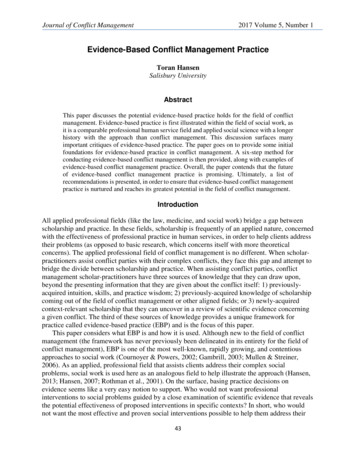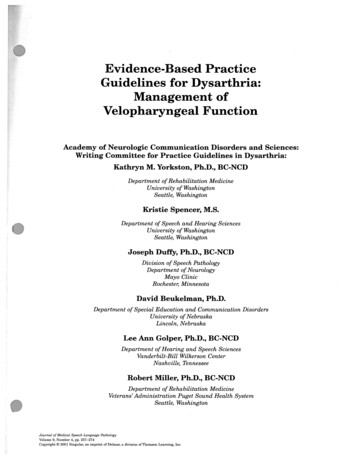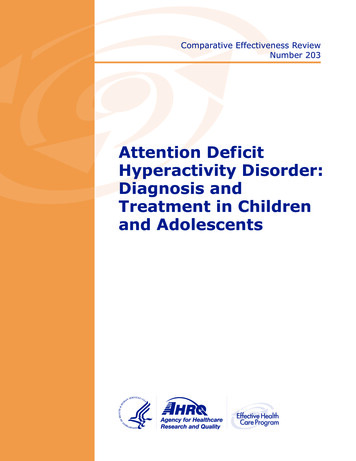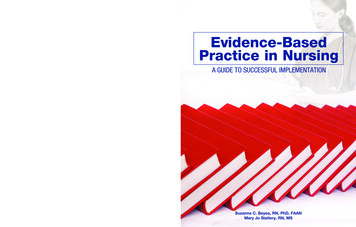
Transcription
A GUIDE TO SUCCESSFUL IMPLEMENTATIONSuzanne C. Beyea, RN, PhD, FAANMary Jo Slattery, RN, MSWant to implement evidence-based practice, but don’t know where to start? Evidence-BasedPractice in Nursing: A Guide to Successful Implementation defines evidence-based practice andexplains how to undertake your own projects. The book provides tips, tools, and resources toallow even novice RNs to practice with success.Also of Interest . . .Evidence-Based Advance Directives: A Study Guide for NursesEvidence-Based Pressure Ulcer Prevention: A Study Guide for NursesEvidence-Based Falls Prevention: A Study Guide for NursesAbout HCProHCPro, Inc., is the premier publisher of information and training resources for the healthcarecommunity. Our line of products includes newsletters, books, audioconferences, traininghandbooks, videos, online learning courses, and professional consulting seminars for specialists in health information management, compliance, accreditation, quality and patient safety,nursing, pharmaceuticals, medical staff, credentialing, long-term care, physician practice,infectioncontrol, and safety.Visit the Healthcare Marketplace at www.hcmarketplace.com for information on any of ourproducts, or to sign up for one or more of our free online e-zines.HCPROP.O. Box 1168 Marblehead, MA 01945www.hcmarketplace.comEvidence-BasedPractice in NursingA GUIDE TO SUCCESSFUL IMPLEMENTATIONSlatteryEBPNEvidence-Based Practice in Nursing: A GUIDE TO SUCCESSFUL IMPLEMENTATION BeyeaEvidence-BasedPractice in NursingSuzanne C. Beyea, RN, PhD, FAANMary Jo Slattery, RN, MS
ContentsAcknowledgments . . . . . . . . . . . . . . . . . . . . . . . . . . . . . . . . . . . . . . . . . . . . . . . . . . . . . . . . . . .vAbout the authors . . . . . . . . . . . . . . . . . . . . . . . . . . . . . . . . . . . . . . . . . . . . . . . . . . . . . . . . . .viiChapter 1: What is evidence-based practice? . . . . . . . . . . . . . . . . . . . . . .1Evidence-based practice . . . . . . . . . . . . . . . . . . . . . . . . . . . . . . . . . . . . . . . . . . . . . . . . . . . . . .1Definitions of research utilization, quality improvement, and nursing research . . . . . . . . . . . .2EBP implications for nurses . . . . . . . . . . . . . . . . . . . . . . . . . . . . . . . . . . . . . . . . . . . . . . . . . . .8Chapter 2: Integration of evidence-based practice . . . . . . . . . . . . . . . . .15First steps to evidence-based practice . . . . . . . . . . . . . . . . . . . . . . . . . . . . . . . . . . . . . . . . . . .15Creating a culture of evidence-based practice . . . . . . . . . . . . . . . . . . . . . . . . . . . . . . . . . . . . .16Creating a forum for discussion . . . . . . . . . . . . . . . . . . . . . . . . . . . . . . . . . . . . . . . . . . . . . . .18Identifying areas of concern . . . . . . . . . . . . . . . . . . . . . . . . . . . . . . . . . . . . . . . . . . . . . . . . . .20Creating internal expertise . . . . . . . . . . . . . . . . . . . . . . . . . . . . . . . . . . . . . . . . . . . . . . . . . . .21Putting research into action . . . . . . . . . . . . . . . . . . . . . . . . . . . . . . . . . . . . . . . . . . . . . . . . . .24Share the knowledge . . . . . . . . . . . . . . . . . . . . . . . . . . . . . . . . . . . . . . . . . . . . . . . . . . . . . . . .25Chapter 3: Accessing and appraising resources . . . . . . . . . . . . . . . . . . .29Resources are widely available . . . . . . . . . . . . . . . . . . . . . . . . . . . . . . . . . . . . . . . . . . . . . . . .29Searching for evidence . . . . . . . . . . . . . . . . . . . . . . . . . . . . . . . . . . . . . . . . . . . . . . . . . . . . . .30Electronic indexes . . . . . . . . . . . . . . . . . . . . . . . . . . . . . . . . . . . . . . . . . . . . . . . . . . . . . . . . . .31Electronic resources . . . . . . . . . . . . . . . . . . . . . . . . . . . . . . . . . . . . . . . . . . . . . . . . . . . . . . . .32Levels of evidence . . . . . . . . . . . . . . . . . . . . . . . . . . . . . . . . . . . . . . . . . . . . . . . . . . . . . . . . . .41Chapter 4: Evidence-based practice becomes a reality. . . . . . . . . . . . . .47Questions for nurses . . . . . . . . . . . . . . . . . . . . . . . . . . . . . . . . . . . . . . . . . . . . . . . . . . . . . . . .47Assess the organization . . . . . . . . . . . . . . . . . . . . . . . . . . . . . . . . . . . . . . . . . . . . . . . . . . . . .48Create a nursing research council or evidence-based practice council . . . . . . . . . . . . . . . . . . .50Models of evidence-based nursing practice . . . . . . . . . . . . . . . . . . . . . . . . . . . . . . . . . . . . . . .56Research champions . . . . . . . . . . . . . . . . . . . . . . . . . . . . . . . . . . . . . . . . . . . . . . . . . . . . . . . .58Education on evidence-based practice . . . . . . . . . . . . . . . . . . . . . . . . . . . . . . . . . . . . . . . . . . .59Evidence-Based Practice in Nursing: A Guide to Successful Implementation 2006 HCPro, Inc.iii
C o n te n t sDissemination of evidence-based practice efforts . . . . . . . . . . . . . . . . . . . . . . . . . . . . . . . . . .60Supporting inquiry . . . . . . . . . . . . . . . . . . . . . . . . . . . . . . . . . . . . . . . . . . . . . . . . . . . . . . . . .61Chapter 5: Journal clubs . . . . . . . . . . . . . . . . . . . . . . . . . . . . . . . . . . .65What are journal clubs? . . . . . . . . . . . . . . . . . . . . . . . . . . . . . . . . . . . . . . . . . . . . . . . . . . . . .65Guidelines for journal clubs . . . . . . . . . . . . . . . . . . . . . . . . . . . . . . . . . . . . . . . . . . . . . . . . . .66Alternative approaches to traditional journal clubs . . . . . . . . . . . . . . . . . . . . . . . . . . . . . . . .67Learning how to critique the nursing literature . . . . . . . . . . . . . . . . . . . . . . . . . . . . . . . . . . . .68Guidelines for the critique of nursing research studies . . . . . . . . . . . . . . . . . . . . . . . . . . . . . .68Chapter 6: Answering questions with nursing research . . . . . . . . . . . . . .73Overview of research methods . . . . . . . . . . . . . . . . . . . . . . . . . . . . . . . . . . . . . . . . . . . . . . . .73Ask a research question . . . . . . . . . . . . . . . . . . . . . . . . . . . . . . . . . . . . . . . . . . . . . . . . . . . . .74Develop a research proposal . . . . . . . . . . . . . . . . . . . . . . . . . . . . . . . . . . . . . . . . . . . . . . . . . .76Have the proposal reviewed . . . . . . . . . . . . . . . . . . . . . . . . . . . . . . . . . . . . . . . . . . . . . . . . . .77Collaborating with external researchers . . . . . . . . . . . . . . . . . . . . . . . . . . . . . . . . . . . . . . . . .82Involve staff nurses in data collection or data analysis . . . . . . . . . . . . . . . . . . . . . . . . . . . . . .83Dissemination: Publications and presentations . . . . . . . . . . . . . . . . . . . . . . . . . . . . . . . . . . . .83Creating a research fellowship . . . . . . . . . . . . . . . . . . . . . . . . . . . . . . . . . . . . . . . . . . . . . . . .84Questions that should not be answered by research . . . . . . . . . . . . . . . . . . . . . . . . . . . . . . . .85Chapter 7: Nursing excellence and evidence-based practice . . . . . . . . . . .89Relationship of nursing excellence to evidence-based practice . . . . . . . . . . . . . . . . . . . . . . . .89Making EBP visible . . . . . . . . . . . . . . . . . . . . . . . . . . . . . . . . . . . . . . . . . . . . . . . . . . . . . . . . .91ANCC Magnet Recognition Program and nursing excellence . . . . . . . . . . . . . . . . . . . . . . . .93Providing evidence for designation . . . . . . . . . . . . . . . . . . . . . . . . . . . . . . . . . . . . . . . . . . . . .95Chapter 8: Examples of evidence-based nursing practice . . . . . . . . . . . .101Engaging the nursing staff . . . . . . . . . . . . . . . . . . . . . . . . . . . . . . . . . . . . . . . . . . . . . . . . . . .101Tailor EBP projects to organizational or departmental efforts . . . . . . . . . . . . . . . . . . . . . . .104Examples of evidence-based projects . . . . . . . . . . . . . . . . . . . . . . . . . . . . . . . . . . . . . . . . . . .106Nursing education instructional guide . . . . . . . . . . . . . . . . . . . . . . . . .113iv 2006 HCPro, Inc.Evidence-Based Practice in Nursing: A Guide to Successful Implementation
C HAPTER1What is evidence-based practice?Learning objectivesAfter reading this chapter, the participant should be able to define evidence-based practice (EBP) differentiate between evidence-based practice, research, research utilization, andquality improvement describe the importance of EBP to nursing practice and high-quality patient careEvidence-based practiceDuring the 1980s, the term “evidence-based medicine” emerged to describe the approach that usedscientific evidence to determine the best practice. Later, the term shifted to become “evidence-basedpractice” as clinicians other than physicians recognized the importance of scientific evidence in clinicaldecision-making. Various definitions of evidence-based practice (EBP) have emerged in the literature,but the most commonly used definition is, “the conscientious, explicit, and judicious use of the current best evidence in making decisions about the care of individual patients” (Sackett, Rosenberg,Gray, Hayes, & Richardson, 1996).Subsequently, experts began to talk about evidence-based healthcare as a process by which researchevidence is used in making decisions about a specific population or group of patients. Evidence-basedpractice and evidence-based healthcare assume that evidence is used in the context of a particularpatient’s preferences and desires, the clinical situation, and the expertise of the clinician. They alsoexpect that healthcare professionals can read, critique, and synthesize research findings and interpretexisting evidence-based clinical practice guidelines.Evidence-Based Practice in Nursing: A Guide to Successful Implementation 2006 HCPro, Inc.1
C h a p te r O n eNurses ask numerous questions when looking to integrate evidence-based practice into theirclinical environment: What exactly is EBP? Is EBP the same as nursing research? What is the difference between EBP and quality improvement? Is EBP relevant to nursing practice?This book examines EBP and demonstrates its relevance to professional nursing practice and highquality patient care.Definitions of research utilization, quality improvement, andnursing researchEvidence-based practice is not research utilization, quality improvement, or nursing research,although it may be related to each of these processes. For example, quality improvement projectsmay be evidence-based, and the findings may contribute to other EBP or research initiatives. Also,an evidence-based practice project can lead to a research study or quality improvement initiative.What is research utilization?For decades, nurses have used available research to guide nursing practice and their efforts toimprove patient outcomes. This process involved critical analysis and evaluation of research findingsand then determining how they fit into clinical practice. Incorporating pertinent research findingsinto clinical practice (and evaluating the changes’ effectiveness), helps close the gap between researchand practice.More recently, research utilization efforts in nursing have been replaced by evidence-based practice,which will be described in further detail later in this chapter.What is quality or performance improvement?Quality, clinical, or performance improvement focuses on systems, processes, and functional,clinical, satisfaction, and cost outcomes. Typically, quality improvement efforts are not designed todevelop nursing practice standards or nursing science, but they may contribute to understandingbest practices or the processes of care in which nurses are actively involved.2 2006 HCPro, Inc.Evidence-Based Practice in Nursing: A Guide to Successful Implementation
What is evidence-based practice?A commonly accepted view is that quality improvement activities in healthcare are not intended togenerate scientific knowledge but rather to serve as management tools to improve the processes andoutcomes within a specific healthcare organization or setting. More recently, experts have focused onimproving care by examining and working within clinical microsystems or the specific places wherepatients, families, and care teams meet (Nelson, et al., 2002). To improve and maintain quality, safety, and efficiency, clinical teams must blend analysis, change, and measurement into their efforts toredesign care within these clinical microsystems.Quality improvement initiatives generally address clinical problems or issues, examine clinicalprocesses, and use specific indicators to help evaluate clinical performance. Data are collected andanalyzed to help understand both the process and the related outcomes. The findings help contributeto efforts to achieve and maintain continuous improvement through ongoing monitoring andimprovement activities.For example, a hospital might be interested in improving its smoking cessation education for hospitalized patients, so it may convene a multidisciplinary team to address the issue. The team maydecide to measure the hospital’s performance using the percentage of discharge summaries that indicate that a smoker received instruction about smoking cessation. The team might implement an educational program and an electronic discharge summary that prompts clinicians to indicate whetherthe patient is a smoker and, if so, whether he or she received smoking cessation advice. They wouldmonitor the rate of compliance and modify the interventions until compliance with the requirementto provide smoking cessation advice is greater than 95%.Quality improvement projects vs. research projectsMany have asked whether quality improvement projects are the same as research projects—they arenot. In clinical practice, these efforts may seem similar in that, for example, both may seek answersto clinical problems and use similar data collection and analysis methods. However, factors that maydiffer include participant or subject recruitment, the study’s methods, and how the results are used.For example, in most quality improvement activities, the participants generally are the patients within a specific clinical microsystem. In research efforts, the investigator recruits human subjects usingapproaches that will ensure a representative sample of the population. In many improvement activities, the intervention may change as it is evaluated, whereas in a research study the treatment orintervention remains the same.Evidence-Based Practice in Nursing: A Guide to Successful Implementation 2006 HCPro, Inc.3
C h a p te r O n eFurthermore, in most quality improvement initiatives, the healthcare team is trying to solve a problem in a particular setting instead of trying to generalize the results of the study to other settingsand populations. Although it might be helpful to learn about the activities and experience of otherimprovement teams, their findings may not apply to or be appropriate in other settings or patientpopulations. The intent of research, however, is to develop new knowledge that can be generalized toother similar populations and clinical settings.Despite the differences between research and quality improvement projects, however, one must consider the protection of human subjects in both. To ensure that you adequately protect the rights ofpatients or subjects, always ask an Institutional Review Board (IRB) to review the research proposalor quality improvement project before implementing the study and beginning data collection.Also note that, whether the effort is research or quality improvement, one goal may be to disseminate the results of the project in a published paper or oral report. For any dissemination project,address adequate human subject protection and adherence with the Health Information Portabilityand Accountability Act of 1996 (HIPAA) guidelines before beginning the improvement project orresearch study. Individuals involved in either quality improvement or research projects should seekadvice from their organization’s IRB, privacy officer, and risk management department to ensure thatdata are managed in a manner consistent with any pertinent federal or state regulations and organizational policies and procedures.Examples of quality improvement projectsSample quality improvement projects that have been conducted in healthcare organizations work todo the following: Reduce the time interval between when a provider writes an antibiotic order to when thepatient receives the first dose Evaluate the effectiveness of a targeted ergonomic program to prevent injuries in nursing personnel Assess the effectiveness of a fast-track program on patient satisfaction in the emergencydepartment Optimize the prevention and treatment of anemia during coronary artery bypass surgery4 2006 HCPro, Inc.Evidence-Based Practice in Nursing: A Guide to Successful Implementation
What is evidence-based practice? Improve the care of patients with Type II diabetes using shared medical appointments Decrease blood stream infections associated with central venous catheters Improve adherence with recommendations for education about smoking cessation Improve and maintain adherence with core best practices in the intensive care unit Improve patient satisfaction through noise reduction activities Assess the effectiveness of using a fall-risk assessment in decreasing the number and severity ofpatient fallsThe above example related to falls could also be an evidence-based practice or research project. Ifafter searching the nursing literature you found another fall-risk assessment tool and you changedpractice in your organization, the information you collected could contribute to an evidence-basedproject. You also might find multiple best practices or nursing interventions related to falls prevention. You can use this information to formulate a research question and conduct a nursing researchstudy within your organization to see which interventions provide the best outcomes in your specificpatient population.Multidisciplinary effortsWithin clinical settings, many such opportunities exist for both nursing and multidisciplinaryimprovement efforts. Improvement activities for nursing can be as simple as reducing time in givingverbal report or improving compliance with documentation requirements. Multidisciplinary collaborative efforts may address complex health issues, such as the care of acute myocardial infarctionpatients or individuals with community-acquired pneumonia.These initiatives are becoming more important in acute care hospitals as the national focus on publicreporting increases. Such efforts help consumers compare the quality of care that various hospitalsprovide. The Centers for Medicare & Medicaid Services (CMS); various organizations that representhospitals, doctors, and employers; accrediting organizations; other federal agencies; and the publichave combined efforts to develop Hospital Compare (www.hospitalcompare.hhs.gov) and, thus, havemade key clinical outcome measures available to the public. In this way, the public can monitor per-Evidence-Based Practice in Nursing: A Guide to Successful Implementation 2006 HCPro, Inc.5
C h a p te r O n eformance indicators to related common medical conditions and certain evidence-based interventionsthat are consistent with achieving the best patient outcomes.Collaboration within multidisciplinary teams creates opportunities to address clinical problems andissues using various perspectives and expertise. Nurses play key roles in such efforts and often benefitfrom the synergy that can be realized by working with others interested in or concerned about theproblem. For example, if an organization determines that patients are experiencing elevated bloodsugars and not achieving good glucose control, a decision might be made to address this issue. Nursesalone can’t solve this problem and need the support of physicians, dieticians, pharmacists, and perhaps other specialists. Bringing together a team of nurses, physicians, and other clinicians concernedabout diabetic care provides opportunities for all members of the team to solve problems creatively.The group can work together while measuring their progress against pre-determined objectives.What is nursing research?Nursing research involves systematic inquiry specifically designed to develop, refine, and extendnursing knowledge. As part of a clinical and professional discipline, nurses have a unique body ofknowledge that addresses nursing practice, administration, and education. Nurse researchers examine problems of specific concern to nurses and the patients, families, and communities they serve.Nursing research methods may be quantitative, qualitative, or mixed (i.e., triangulated): In quantitative studies, researchers use objective, quantifiable data (such as blood pressure orpulse rate) or use a survey instrument to measure knowledge, attitudes, beliefs, or experiences Qualitative researchers use methods such as interviews or narrative analyses to help understand a particular phenomenon Triangulated approaches use both quantitative and qualitative methodsRegardless of the method they use, researchers must adhere to certain approaches to ensure both thequality and the accuracy of the data and related analyses. The intent of each approach is to answerquestions and develop knowledge using the scientific method.6 2006 HCPro, Inc.Evidence-Based Practice in Nursing: A Guide to Successful Implementation
What is evidence-based practice?Examples of nursing research projectsExamples of nursing research projects include the following: Randomized clinical trial examining best practice for orthopedic-pin site care Efficacy of examination gloves for simple dressing changes Reliability of methods used to determine nasogastric tube placement The effects of relaxation and guided imagery on preoperative anxiety Quality of life in patients with chronic pain The relationship of a preoperative teaching program for joint replacement surgery andpatient outcomesThe scientific method involves collecting observable, measurable, and verifiable data in a prescribedmanner so as to describe, explain, or predict outcomes. For example, one might collect data todescribe the effects of massage on blood pressure, explain decreased needs for sedation, or predictlower levels of anxiety.Research methods demand that the collected data remain objective and not be influenced by theresearcher’s hypotheses, beliefs, or values. In the massage example, the researcher could easily biasthe results by administering the massages or collecting the data. Using certain approaches to subjectrecruitment, performing faulty data collection, and not controlling for other confounding variablesalso can bias research findings. Therefore, when developing a study proposal, the researcher mustdevelop a plan that minimizes these risks and supports the development of reliable informationand results.Conducting nursing research is not as simple as saying, “I want to do research.” To conduct a scientific investigation, the researcher must have adequate training and resources. Developing and implementing a well-designed study with adequate control requires extensive knowledge of researchmethods and processes. Therefore, nurses interested in conducting research may work with an experienced researcher or develop their own skills by taking statistics and research methods courses andby being mentored by someone with research skills. One approach that staff nurses can take to getinvolved in research is to learn about and get involved in efforts related to evidence-based nursingpractice. Working with others who have expertise in evidence-based practice serves as a helpful introduction into the processes of critiquing, analyzing, and evaluating published research, which is anecessary step in any research activity.Evidence-Based Practice in Nursing: A Guide to Successful Implementation 2006 HCPro, Inc.7
C h a p te r O n eEBP implications for nursesNurses serve instrumental roles in ensuring and providing evidence-based practice. They must continually ask the questions, “What is the evidence for this intervention?” or “How do we provide bestpractice?” and “Are these the highest achievable outcomes for the patient, family, and nurse?” Nursesare also well positioned to work with other members of the healthcare team to identify clinical problems and use existing evidence to improve practice. Numerous opportunities exist for nurses to question current nursing practices and use evidence to make care more effective.For example, a recently published evidence-based project describes the potential benefits of discontinuing the routine practice of listening to the bowel sounds of patients who have undergone electiveabdominal surgery. The authors reviewed the literature and conducted an assessment of currentpractice, and they subsequently developed and evaluated a new practice guideline. These authorsreported that clinical parameters such as the return of flatus and first postoperative bowel movementwere more helpful than bowel sounds in determining the return of gastrointestinal mobility afterabdominal surgery. The authors found that this evidence-based project resulted in saving nursingtime without having negative patient outcomes (Madsen et al., 2005).Nurses throughout the country also have been involved in multidisciplinary efforts to reduce thenumber and severity of falls and pressure ulcers/injuries. Such projects can help save money andimprove care processes and outcomes. By implementing existing evidence-based guidelines related tofalls and pressure ulcers/injuries, care has improved, and the number and severity of negative outcomes have decreased. Other examples of evidence-based healthcare efforts include projects toincrease compliance with requirements for screenings for cancer and improving glucose control.Importance of evidence-based practiceEvidence-based practice helps nurses provide high-quality patient care based on research and knowledge rather than because “this is the way we have always done it,” or based on traditions, myths,hunches, advice of colleagues, or outdated textbooks.For example, when clinical questions arise, should one look to a nursing textbook for the answers?Remember that books are not published every year, and new information may not be included in theedition you have. Also, when using textbooks, consider whether you have the most current edition.There are also issues to consider when asking colleagues for advice—specifically, be mindful that their8 2006 HCPro, Inc.Evidence-Based Practice in Nursing: A Guide to Successful Implementation
What is evidence-based practice?responses may be based on their personal experiences, their observations, what they learned in school,what was reviewed during nursing orientation, or myths and traditions learned in clinical practice.A recent study provided evidence that most nurses provide care in accordance with what theylearned in nursing school and rarely used journal articles, research reports, and hospital librariesfor reference (Pravikoff, Tanner, & Pierce, 2005). That finding, combined with the fact that the average nurse is more than 40 years of age, makes it apparent that many nurses’ knowledge is probablyoutdated. Practice based on such knowledge does not translate into quality patient care or healthoutcomes. Evidence-based practice provides a critical strategy to ensure that care is up to date andthat it reflects the latest research evidence.Tips for SuccessWhy bother with EBP? It allows nurses to implement the mostup-to-date, research-tested, and high-quality patient care.Why is EBP important to nursing practice? It results in better patient outcomes It contributes to the science of nursing It keeps practice current and relevant It increases confidence in decision-making Policies and procedures are current and include the latest research, thus supportingJCAHO-readiness Integration of EBP into nursing practice is essential for high-quality patient care and achievement of ANCC Magnet Recognition Program (MRP) designationOften, nurses feel that they are using “evidence” to guide practice, but their sources of evidence arenot research-based. In a study conducted by Thompson, et al., (2003), nurses reported that the mosthelpful knowledge source was experience or advice from colleagues or patients. Of concern werereports that up-to-date electronic resources that included evidence-based materials were not useful tonurses in clinical practice. This barrier contributes to significant gaps in clinicians applying researchEvidence-Based Practice in Nursing: A Guide to Successful Implementation 2006 HCPro, Inc.9
C h a p te r O n efindings to practice and dissemination of innovations. The failure to use evidence results in care thatis of lower quality, less effective, and more expensive (Berwick, 2003).Evidence-based practice can be easier for nurses to use if they refer to already-developed evidencebased or clinical practice guidelines. Numerous expert groups have already undertaken systematicefforts to develop guidelines to help both healthcare providers and patients make informed decisionsabout care interventions. Guideline developers use a systematic approach to critique the existingresearch, rate the strength of the evidence, and establish practice guidelines. The overall goal of thesetypes of efforts focuses on guiding practice and minimizing the variability in care.For example in 2002, the Centers for Disease Control and Prevention published Guideline for HandHygiene in Health-Care Settings, which provides healthcare workers with a review of data regardinghand-washing and hand antisepsis in healthcare environments. Furt
Quality improvement projects vs. research projects Many have asked whether quality improvement projects are the same as research projects—they are not. In clinical practice, these efforts may seem similar in that, for example, both may seek answers to clinical problems and use similar data collection and analysis methods. However, factors .


